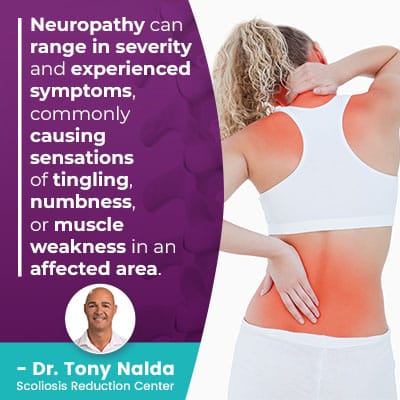Can Scoliosis Cause Numbness? Scoliosis and Neuropathy

As a spinal condition, many assume the effects of scoliosis would be isolated to the back, but that’s not the case. The spine is part of the central nervous system, and once there is a degree of nerve involvement, either in terms of irritation, inflammation, impingement, or compression, radicular pain and neuropathy can develop.
The brain and spine work together to form the body’s central nervous system, which is why spinal conditions can cause a number of symptoms. The spinal canal houses 31 pairs of spinal nerves, so an unnatural spinal curve can compress the nerves within, causing numbness and neuropathy.
Before getting to the specific connection between scoliosis and neuropathy, let’s first explore each condition on its own.
What is Scoliosis?
Scoliosis is a highly-prevalent spinal condition that involves the development of an unnatural sideways spinal curve, with rotation, and a minimum Cobb angle measurement of 10 degrees.
A patient’s Cobb angle is taken during X-ray and involves drawing lines from the tops and bottoms of the curve’s most-tilted vertebrae.
The resulting angle is expressed in degrees and further classifies conditions in terms of severity:
- Mild scoliosis: Cobb angle measurement of between 10 and 25 degrees
- Moderate scoliosis: Cobb angle measurement of between 25 and 40 degrees
- Severe scoliosis: Cobb angle measurement of 40+ degrees
- Very-severe scoliosis: Cobb angle measurement of 80+ degrees
As you can see from the wide range of Cobb angle measurements, scoliosis is a highly-variable condition, and in addition, it’s progressive.
Progressive conditions have it in their very nature to worsen over time, particularly if left untreated or not treated proactively.
So, where a scoliosis is at the time of diagnosis is not indicative of where it will stay; even if a person doesn’t initially experience a lot of condition-related symptoms, like numbness, they can develop over time as the condition progresses.
Scoliosis progressing means the unnatural spinal curve is increasing in size, and this means the uneven forces being introduced to the body are also increasing, and in most cases, the more severe the condition, the more likely it is to cause additional complications, such as neuropathy.
So now that we’ve defined scoliosis and the parameters that have to be met in order to be diagnosed with scoliosis, let’s move on to defining neuropathy.
What is Neuropathy?
 Having neuropathy means one or more nerves have been damaged or impaired to the point of their function being altered.
Having neuropathy means one or more nerves have been damaged or impaired to the point of their function being altered.
Neuropathy can range in severity and experienced symptoms, commonly causing sensations of tingling, numbness, or muscle weakness in an affected area.
Often, the first effects of neuropathy are felt in the hands and feet, but its effects can be felt throughout the body.
The brain and spine work in tandem to form the body’s central nervous system (CNS), and the peripheral nervous system (PNS) is made up of the brain and cranial nerves that connect the brain to the spinal cord.
The central nervous system is often compared to a control center because it facilitates brain-body communication.
The nervous system is a vast network of cells and nerves that connect the brain and spinal cord to the rest of the body; it does this through the sending/receiving of signals, and this includes signals to the hands, feet, legs, arms, internal organs, muscles, the face, and mouth.
When neuropathy becomes an issue, it means the nerves aren’t functioning optimally because they are damaged, and this commonly involves sending incorrect messages and signals throughout the body; for example, nerves can fail to send pain signals when there’s pain, and vice versa.
Neuropathy is a complex condition because its effects are unpredictable, and when it comes to treating neuropathy, the condition’s underlying cause has to be first determined.
If the underlying cause is left undetermined, treatment will only be addressing the condition’s symptoms, and not the condition itself.
There are different causes of neuropathy, from illness to injury, infection, or an underlying condition like scoliosis.
Before we connect scoliosis to neuropathy, let’s first address some of the different types of neuropathy, as each has its own characteristics and treatment needs.
Types of Neuropathy
There are more than 100 different forms of peripheral neuropathy, and neuropathies are further specified by the type of nerve damage that’s involved.
Mononeuropathy refers to damage to a single nerve, and polyneuropathy is more common and involves multiple nerves.
The three main types of peripheral nerves are sensory, motor, and autonomic, and experienced neuropathy symptoms will vary based not only on the degree of nerve involvement but also the type of nerves involved.
Sensory nerves control sensation by connecting to the skin, while motor nerves control movement, reflexes, and coordination by connecting to the muscles; the autonomic nerves control breathing, heart rate, and digestion by connecting to the body’s internal organs.
 Neuropathy can involve a single nerve type or all three.
Neuropathy can involve a single nerve type or all three.
Some common symptoms of sensory neuropathy can include:
- Sensations of burning, numbness, or tingling in the hands or feet
- Paresthesias (strange sensations)
- Changes to coordination
- Changes to reflexes
- Pain
- Inability to feel pain, sensations like touch, or temperature changes
Some common symptoms of motor neuropathy can include:
- Loss of muscular control
- Muscle weakness
- Muscle twitches
- Muscle spasms
- Coordination issues
- Balance issues
- Reduced range of motion in the affected area
Some common symptoms of autonomic neuropathy can include:
- Fainting spells
- Dizziness
- Diarrhea
- Nausea
- Vomiting
- Blood pressure drops and spikes
- Abnormal heart rate
- Sexual dysfunction
As you can see from the wide range of symptoms, they vary based on the type of nerve involvement, which is what makes neuropathy so unpredictable, sometimes causing chronic and debilitating nerve pain, and other times causing intermittent flare-ups with periods of remission in between.
It’s estimated that neuropathy is caused by diabetes in approximately 30 percent of cases, and 30-40 percent are classified as idiopathic: meaning we don’t know what caused it to develop.
Now that we have discussed the different types of neuropathy and associated symptoms, let’s explore the connection between neuropathy and scoliosis.
Scoliosis and Neuropathy
While scoliosis is more closely tied to the function of the central nervous system, in severe forms, the connection between the peripheral nervous system nerves and the central nervous system nerves can also be affected.
As it’s the motor nerves that control movement and muscles, scoliosis is most closely associated with motor neuropathy. This is because it’s not just the spine that maintains its natural curves and alignment, but also the spine’s surrounding muscles that provide it with support and stabilization.
If communication between the brain and the rest of the body is disrupted, this includes the muscles, and if a scoliotic curve is compressing the spine and its surrounding nerves, muscles, and vessels, the nerves can become damaged or destroyed: affecting their ability to function.
As scoliosis can impact overall spinal health and function, it can cause neuropathy by affecting the spinal nerves and the connection between the nerves of the CNS and PNS. It can also cause neuropathy by making the spine more vulnerable to developing spinal conditions known to impact nervous-system activity and function.
Conclusion
As a structural spinal condition, scoliosis can cause a number of effects felt throughout the body, and not just the back.
Because the spine and brain work in tandem to facilitate brain-body communication, the spine’s involved in the function of virtually every system within the body.
A scoliotic curve is unnatural, so it’s introducing a lot of uneven forces to the body, causing adverse spinal tension that affects not just the spine, but also its surrounding vessels, muscles, and nerves.
Particularly in severe scoliosis, if left untreated, neuropathy can develop as the spinal nerves are exposed to constant compression, which can cause nerves to become irritated, inflamed, damaged, or destroyed.
Also, as the spine’s natural curves make it stronger, more flexible, and better able to absorb/distribute mechanical stress, a loss of the spine’s healthy curves disrupts the spine’s biomechanics, impacting its overall health and making it vulnerable to a number of spinal conditions/issues.
Here at the Scoliosis Reduction Center, I have experience treating a wide range of spinal conditions, and the keystone of my approach is being proactive in an effort to prevent progression, increasing condition severity, and the increasing likelihood of developing complications like neuropathy.
When neuropathy is caused by scoliosis, I don’t just treat the neuropathy as that would be only addressing its symptoms; I treat scoliosis, that’s the underlying cause of the neuropathy.
By applying condition-specific chiropractic care to reduce scoliosis on a structural level, in the form of a curvature reduction, and working to increase core strength through physical therapy and scoliosis-specific exercises (SSEs), the condition’s uneven forces are reduced and the spine can be optimally supported by its surrounding muscles.
Ultimately, I want to prevent issues, such as neuropathy, from ever developing by proactively treating scoliosis so the pressure on affected nerves is reduced and neuropathy symptoms either never develop or are improved.
Dr. Tony Nalda
DOCTOR OF CHIROPRACTIC
After receiving an undergraduate degree in psychology and his Doctorate of Chiropractic from Life University, Dr. Nalda settled in Celebration, Florida and proceeded to build one of Central Florida’s most successful chiropractic clinics.
His experience with patients suffering from scoliosis, and the confusion and frustration they faced, led him to seek a specialty in scoliosis care. In 2006 he completed his Intensive Care Certification from CLEAR Institute, a leading scoliosis educational and certification center.
About Dr. Tony Nalda
 Ready to explore scoliosis treatment? Contact Us Now
Ready to explore scoliosis treatment? Contact Us Now





